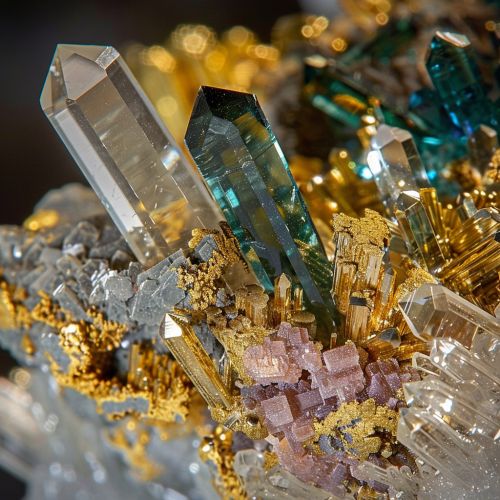Non-silicate minerals
Introduction
Non-silicate minerals are a diverse group of mineral species that do not contain silicon and oxygen, the two most abundant elements in the Earth's crust. They include a wide range of minerals, from precious metals like gold and silver, to industrial minerals like gypsum, halite, and graphite. Non-silicate minerals are important for their economic value as well as their role in geological processes.
Classification
Non-silicate minerals can be classified into several major groups based on their chemical composition. These groups include native elements, sulfides, oxides, halides, carbonates, sulfates, phosphates, and organic minerals.
Native Elements
Native elements are minerals composed of a single element. This group includes precious metals such as gold, silver, and platinum, as well as other elements like sulfur and carbon in the form of diamond and graphite.


Sulfides
Sulfides are minerals that contain sulfur combined with one or more metals. Examples include pyrite (FeS2), also known as fool's gold, and galena (PbS), the primary ore of lead.
Oxides
Oxides are composed of oxygen combined with one or more metals. Examples include hematite (Fe2O3), an important iron ore, and corundum (Al2O3), which forms gemstones like ruby and sapphire when it contains trace amounts of certain other elements.
Halides
Halides are minerals that contain a halogen (fluorine, chlorine, iodine, or bromine) combined with one or more other elements. Examples include halite (NaCl), or rock salt, and fluorite (CaF2).
Carbonates
Carbonates are minerals that contain the carbonate ion (CO3) combined with one or more metals. Examples include calcite (CaCO3), the primary component of limestone, and dolomite ((Ca,Mg)CO3).
Sulfates
Sulfates are minerals that contain the sulfate ion (SO4) combined with one or more metals. Examples include gypsum (CaSO4·2H2O) and anhydrite (CaSO4).
Phosphates
Phosphates are minerals that contain the phosphate ion (PO4) combined with one or more metals. Examples include apatite ([Ca5(PO4)3F]) and monazite ((Ce,La,Nd,Th)PO4).
Organic Minerals
Organic minerals are minerals of biological origin. Examples include amber, which is fossilized tree resin, and pearls, which are produced by mollusks.
Economic Importance
Non-silicate minerals play a crucial role in the global economy. Many are mined for their metallic content. Gold, silver, and platinum, for example, are used in jewelry and electronics. Iron ore, a type of oxide, is used to make steel. Other non-silicate minerals, like gypsum and halite, are used in construction and food preparation, respectively.
Role in Geological Processes
Non-silicate minerals also play key roles in various geological processes. For example, the dissolution and precipitation of carbonate minerals is a crucial part of the carbon cycle. Oxidation of sulfide minerals is a major source of acid mine drainage, a serious environmental problem.
